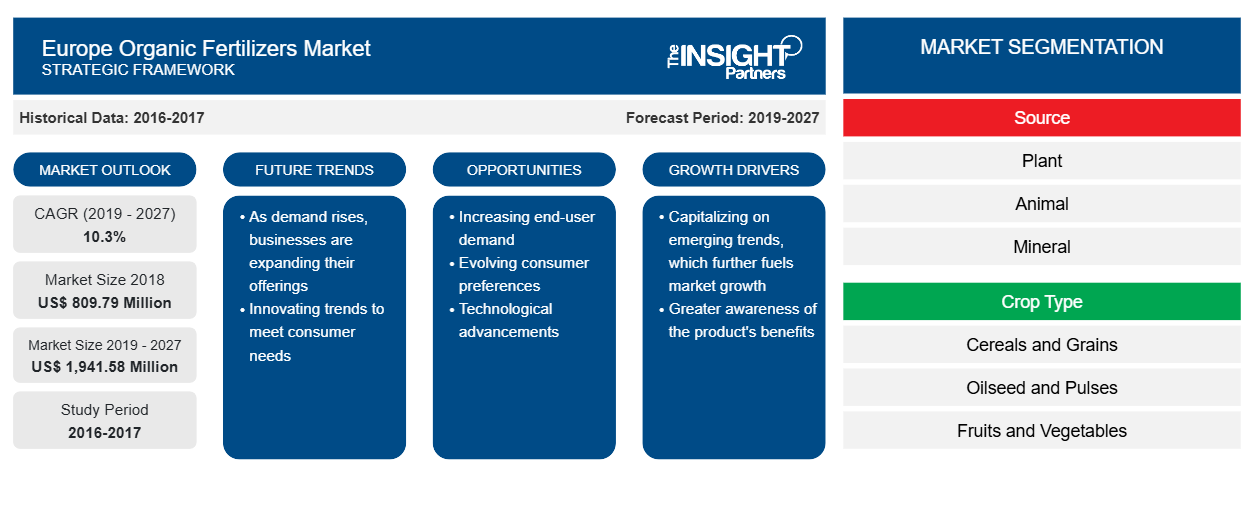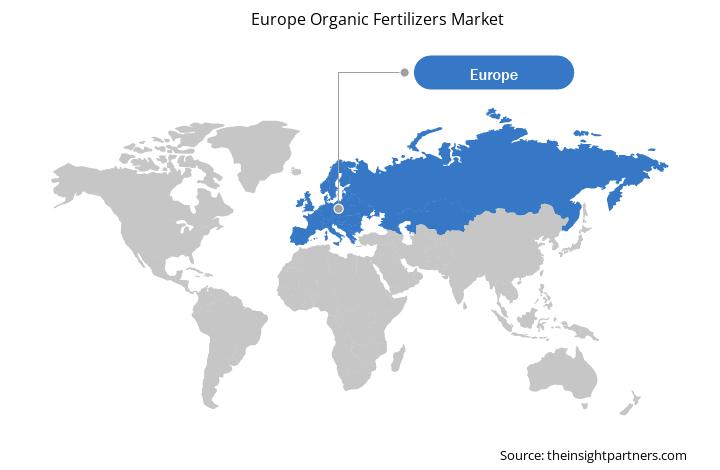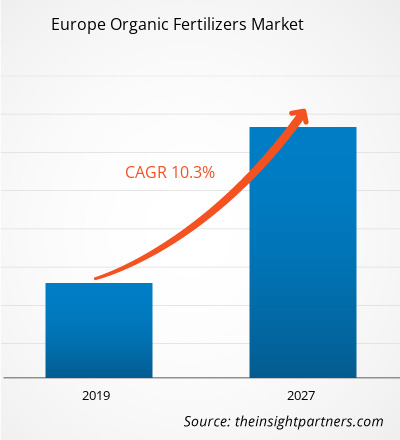预计到2031年,欧洲有机肥料市场规模将从2024年的25.8亿美元增至40.1亿美元。预计2025年至2031年期间,该市场的复合年增长率将达到6.6%。精准农业很可能在预测期内为市场带来新的趋势。
欧洲有机肥料市场分析
欧洲有机肥料市场受到强有力的环境政策、日益增长的有机食品消费者需求以及可持续农业实践日益普及的推动。根据有机农业研究所发布的《2024年世界有机农业报告》,2022年,欧洲将有近1850万公顷的农业用地用于有机农业。2004年至2022年,全球有机柑橘种植面积增加了8.6万公顷以上;欧洲是其中最重要的贡献者之一,其中意大利和西班牙是最大的有机柑橘生产国。欧盟委员会提出的“欧洲绿色协议”、“从农场到餐桌”和“生物多样性战略”等倡议旨在到2030年实现可持续的粮食体系。
欧洲有机肥料市场概况
德国、法国、意大利和英国是有机肥料市场的领导者。根据《2024 年世界有机农业报告》,2022 年欧洲有机产品零售额达到 550 亿美元。根据 Benefert BV 的数据,法国以 290 万公顷的有机土地在欧盟中领先,其次是西班牙、意大利和德国。奥地利、爱沙尼亚和瑞典拥有最大的有机农田份额。德国是该地区有机肥料的重要消费国。根据农业经济研究所的数据,截至 2023 年,德国有 36,680 个农场(占地约 189 万公顷)按照有机农业标准运营。因此,政府的可持续农业政策和向有机农业实践的转变促进了欧洲有机肥料市场的增长。
定制此报告以满足您的要求
您可以免费定制任何报告,包括本报告的部分内容、国家级分析、Excel 数据包,以及为初创企业和大学提供优惠和折扣
欧洲有机肥料市场:战略洞察

- 获取此报告的顶级关键市场趋势。此免费样品将包括数据分析,从市场趋势到估计和预测。
欧洲有机肥料市场驱动因素和机遇
化肥公司的战略举措推动欧洲有机肥料市场增长
欧洲有机肥料市场的主要公司正在实施多项战略举措,以扩大市场份额、提高作物可持续性并满足不断增长的消费者需求。这些举措侧重于供应链改进、技术进步、认证计划、合作伙伴关系以及研发投资。有机食品生产商、零售商、农业综合企业等在塑造有机农业生态系统方面发挥着至关重要的作用。有机肥料公司正在投资农业研究和生物技术,以应对有机农业面临的挑战,包括产量限制和病虫害防治。例如,两家知名的合成肥料生产商拜耳公司和先正达公司正在探索有机肥料和土壤健康解决方案。此外,2023年3月,Benefert BV宣布推出BeneSOL 3-3-6有机肥料,旨在提高水果种植产量。
欧洲有机肥料市场的企业专注于新产品的推出,以满足日益增长的消费者需求,并助力循环经济转型。2024年,雅苒推出了专为再生农业设计的YaraSuna有机肥料产品组合。该产品系列为所有农民提供补充,以支持土壤健康并增强作物抗逆性。它包含六种生物农业许可的有机和有机矿物产品,采用特殊的微粒配方,有机碳含量高达约30%。2024年1月,Miven推出了一款由植物基材料制成的纯素有机颗粒液体肥料;该产品部分原料来自农业废弃物,旨在改善土壤特性和土壤结构。
政府法规和政策支持有机农业创造市场增长机会
一些欧洲国家政府正在实施法规和政策,以推广有机农业,并将其作为其更广泛的可持续发展和粮食安全战略的一部分。这些政策侧重于财政激励、认证标准和研究支持,以促进整体市场发展,鼓励从传统农业向有机农业转型。几乎所有欧盟成员国都通过欧盟范围内的法律定义、农业环境转换和维护补贴、农村发展营销和加工补助、推广资助计划以及公共采购和研究与信息计划来支持有机农业。2020年,欧盟委员会启动了“从农场到餐桌”战略,该战略设定了一系列目标,以提高欧盟粮食生产的可持续性。这些目标包括减少50%的农药使用量和20%的化肥使用量;此外,该战略还旨在将有机农业占农业用地的比例提高到25%。一些欧洲国家已设定目标,以扩大其有机农田面积,以实现这一目标。例如,德国政府的目标是到2030年将30%的农业用地用于有机农业。
欧洲有机肥料市场报告细分分析
有助于得出欧洲有机肥料市场分析的关键部分是来源、形式和作物类型。
- 根据来源,市场分为植物、动物和矿物。2024年,植物部分占据了最大的市场份额。
- 按形态划分,市场分为干型和液态。2024年,干型市场占据了更大的市场份额。
- 就作物类型而言,市场细分为水果蔬菜、谷物、草皮和观赏植物、花卉和苗圃、树木作物、豆类、香草和香料、油籽等。2024年,油籽占据了市场主导地位。
欧洲有机肥料市场份额按地域分析
欧洲有机肥料市场的地理范围主要分为德国、法国、意大利、西班牙、英国和欧洲其他地区。
2024 年,意大利在欧洲有机肥料市场占有相当大的份额。根据意大利农业和食品市场服务研究所 2024 年发布的报告,用于有机农业的农业用地显著增长,2023 年达到 245 万公顷,比 2022 年增长 4.5%。2022 年,意大利政府投资 30 亿美元鼓励有机农业,旨在到 2027 年将 25% 的农业用地的传统做法转变为有机农业。报告还显示,2023 年该国有机种植的橄榄树面积约为 279,766 公顷。2023 年,大部分有机橄榄产自意大利南部。因此,在政府支持政策的推动下,有机农业的兴起预计将在不久的将来推动意大利有机肥料市场的增长。
欧洲有机肥料市场区域洞察
Insight Partners 的分析师已详尽阐述了预测期内影响欧洲有机肥料市场的区域趋势和因素。本节还讨论了欧洲有机肥料市场在北美、欧洲、亚太地区、中东和非洲以及南美和中美的细分市场和地理分布。

- 获取欧洲有机肥料市场的区域具体数据
欧洲有机肥料市场报告范围
| 报告属性 | 细节 |
|---|---|
| 2024年的市场规模 | 25.8亿美元 |
| 2031年的市场规模 | 40.1亿美元 |
| 全球复合年增长率(2025-2031) | 6.6% |
| 史料 | 2021-2023 |
| 预测期 | 2025-2031 |
| 涵盖的领域 | 按来源
|
| 覆盖地区和国家 | 欧洲
|
| 市场领导者和主要公司简介 |
|
欧洲有机肥料市场参与者密度:了解其对业务动态的影响
欧洲有机肥料市场正在快速增长,这得益于终端用户需求的不断增长,而这些需求的驱动因素包括消费者偏好的转变、技术进步以及对产品优势的认知度的提升。随着需求的增长,企业正在扩大产品线,不断创新以满足消费者需求,并抓住新兴趋势,从而进一步推动市场增长。
市场参与者密度是指特定市场或行业内企业或公司的分布情况。它表明特定市场空间内竞争对手(市场参与者)的数量相对于其规模或总市值而言。
在欧洲有机肥料市场运营的主要公司有:
- 安吉博
- 雅苒国际股份有限公司
- ICL集团有限公司
- 你好自然国际有限公司
- 印度农民肥料合作社有限公司(IFFCO)
- 科罗曼德国际有限公司
免责声明:以上列出的公司没有按照任何特定顺序排列。

- 获取欧洲有机肥料市场主要参与者概览
欧洲有机肥料市场新闻及最新发展
欧洲有机肥料市场评估通过收集一手和二手资料进行定性和定量分析,包括重要的企业出版物、协会数据和数据库。市场近期的主要发展如下:
- 雅苒收购了意大利有机肥公司 Agribios Italiana,该公司专注于生产高品质有机肥。此次收购旨在扩大其产品线,促进再生农业发展,并改善土壤健康。Agribios 预计到 2022 年产量将达到 6 万千吨,占据意大利有机肥市场 10% 的份额。(来源:雅苒国际,新闻稿,2024 年 4 月)
- Miven推出了一款纯素有机颗粒液体肥料,该肥料由植物基材料制成,部分原料来自农业废弃物,旨在改善土壤特性和土壤结构。(来源:Miven,新闻通讯,2024年1月)
欧洲有机肥料市场报告覆盖范围及交付成果
《欧洲有机肥料市场规模和预测(2021-2031)》报告对以下领域进行了详细的市场分析:
- 欧洲有机肥料市场份额以及区域和国家层面所有主要市场领域的预测
- 欧洲有机肥料市场趋势以及市场动态,如驱动因素、限制因素和关键机遇
- 详细的波特五力模型和 SWOT 分析
- 欧洲有机肥料市场涵盖主要市场趋势、区域框架、主要参与者、法规和最新市场发展
- 行业格局和竞争分析,涵盖市场集中度、热图分析、知名参与者以及欧洲有机肥料市场的最新发展
- 详细的公司简介
- 历史分析(2 年)、基准年、预测(7 年)及复合年增长率
- PEST和SWOT分析
- 市场规模、价值/数量 - 全球、区域、国家
- 行业和竞争格局
- Excel 数据集
近期报告
客户评价
购买理由
- 明智的决策
- 了解市场动态
- 竞争分析
- 客户洞察
- 市场预测
- 风险规避
- 战略规划
- 投资论证
- 识别新兴市场
- 优化营销策略
- 提升运营效率
- 顺应监管趋势




















 获取免费样品 - 欧洲有机肥料市场
获取免费样品 - 欧洲有机肥料市场